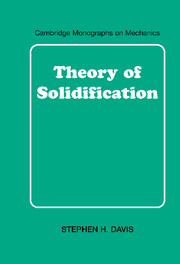6 - Disequilibrium
Published online by Cambridge University Press: 20 January 2010
Summary
Several processes exist in which a high-power electron or laser beam is focused on the surface of a body. If the beam is stationary with respect to the body, a small, perhaps axisymmetric, pool of liquefied metal is formed, as shown in Figure 6.1(a). This state may be steady, though the liquid may undergo convective motions caused by buoyancy or thermocapillary convection.
If the beam is now translated at some speed VT, the pool translates as well, as shown in Figure 6.1(b). Now the pool is asymmetric, and melting takes place ahead of the beam whereas solidification occurs behind it; typically VT ≈ 1 − 10 m/s. At the rear, one might regard the front as undergoing unidirectional solidification at speed VT sin θ, where θ measures the angle between the planer solid surface and the front. At such high solidification rates, new, nonequilibrium microstructures are formed in the solid after the liquid freezes.
Boettinger et al. (1984) observed what seem to be two-dimensional bands in Ag–Cu alloys in which layers of cells (or dendrites or eutectics) and segregation-free material alternate in the growth direction. Figure 6.2b is a sketch of the configuration. Bands are not a mode that emerges from Mullins-Sekerka theory. Since this work, bands have been seen in many metallic alloy systems, as discussed by Kurz and Trivedi (1990).
As VT is increased, the bands disappear and only a segregation-free material is produced, which is consistent with a modified version of the Mullins and Sekerka (1964) theory of morphological instability.
- Type
- Chapter
- Information
- Theory of Solidification , pp. 162 - 214Publisher: Cambridge University PressPrint publication year: 2001

